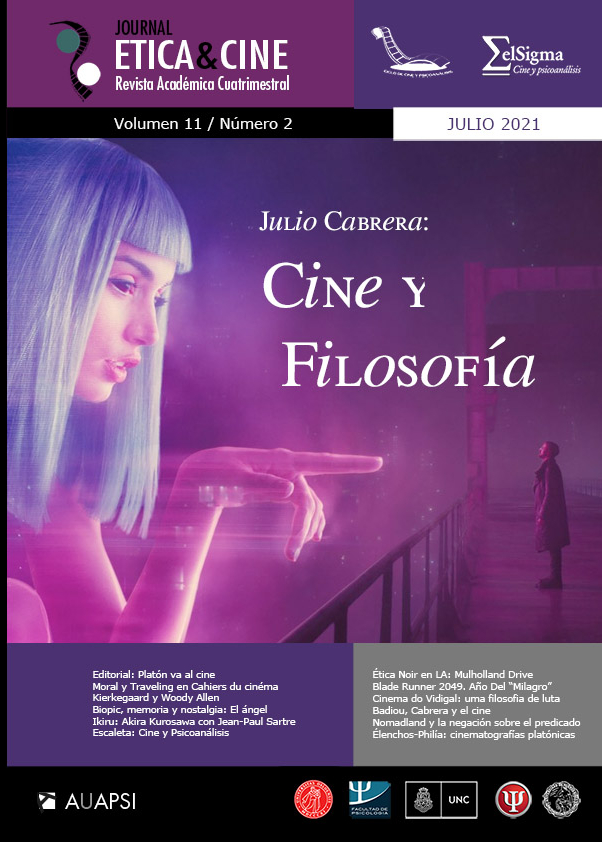Cinema and Psychoanalysis
DOI:
https://doi.org/10.31056/2250.5415.v11.n2.34187Keywords:
Apollonian, Dionysian, Real, Art, TruthAbstract
The present work aims to address, through a brief tour of various artistic manifestations and ideas of philosophical thought, the concepts of the Apollonian and the Dionysian. These two concepts –reflected in the scientific tradition and art, respectively– summarize two opposing approaches to dealing with the Real, either through Reason or through aesthetic experience. It is also argued that –for instance– cinema and psychoanalysis represent an articulation of the Apollonian and the Dionysian. In any case, the relationships with the truth of both the analytical experience and the artistic experience are discussed and it is proposed that both are directed to show the Real, that is, that truth that cannot be described in words.
Downloads
References
Aristóteles. (1974). Poética de Aristóteles. Edición trilingüe por García Yerba, V. Editorial Gredos.
Bazin, A. (1958-63/1999). ¿Qué es el cine? Ediciones Rialp.
Bettelheim, B. (1975). The uses of enchantment. The meaning and importance of fairy tales. Int.: EPUB GRATIS. Org.
Breuer, J., y Freud, S. (1893-95/1976). Estudios sobre la histeria. En S. Freud, Obras completas. Vol. II. Amorrortu Editores.
Canudo, R. (1911/2020). Manifiesto de las siete artes. Obtenido de Proyecto IDIS: https://proyectoidis.org/manifiesto-de-las-siete-artes/
Carrasco Pirard, E. (2010). El hombre y lo otro. Ensayos sobre Nietzche, Heidegger y Sartre. Editorial Universitaria.
Chancerel, L. (1940/1963). El teatro y los comediantes. Breve historia del arte y los artistas. EUDEBA.
Coen, E., & Coen, J. (Dirección). (2016). Hail, Caesar! [Película].
Deleuze, G. (1978/2008). Kant y el tiempo. Equipo Editorial Cactus.
Deleuze, G. (1983/1994). La imágen-movimiento. Estudios sobre cine 1. Paidós Comunicación.
Foucault, M. (1969/2000-5). ¿Qué es un autor? Obtenido de http://23118.psi.uba.ar/academica/carrerasdegrado/musicoterapia/informacion_adicional/311_escuelas_psicologicas/docs/Foucault_Que_autor.pdf
Foucault, M. (1969/2002). Arqueología del saber. Siglo XXI Editores.
Foucault, M. (1981-2/2010). La hermenéutica del sujeto. De la Piqueta.
Freud, S. (1900/2001). Obras Completas. Tomo V. La interpretacion de los sueños. Amorrortu Editores.
Gadamer, H.-G. (2001). Palabra e imágen: "así de verdadero, así de óntico" (1992). En Antologia (págs. 135-150). Ediciones Sígueme.
Garibay K., A. M. (1964/1997). Mitología Griega. Dioses y héroes. Editorial Porrúa.
Graves, R. (1955/2007). Los mitos griegos. Vol 1. Alianza Editores.
Hazanavicius, M. (Dirección). (2011). The Artist [Película].
Hoffman, M. (Dirección). (1999). A Midsummer Night’s Dream [Película].
Hume, D. (1757/2003). De la tragedia y otros ensayos sobre el gusto. Editorial Biblos.
Lacan, J. (1964/1987). El seminario. Libro 11. Cuatro conceptos fundamentales del Psicoanálisis. Paidos.
Lamet, P. M., Rodenas, J. M., & Gallego, D. (1968). Lecciones de cine. Historia, estética y sociología. II. Ed. Mensajero del Corazón de Jesús.
Longhurst, R. S. (1957/1973). Geometrical and physical optics. 3erd Ed. Longman.
Macgowan, K., & Melnitz, W. (1959/1987). Las edades de oro del teatro. Fondo de Cultura Económica.
Milerson, G. (1991). The technique of lighting for television and film.- 3rd. ed. Focal Press.
Motta, C. G. (2013). Las películas que Lacan vio y aplicó al psicoanálisis. Editorial Paidós.
Nitetzsche, F. (1871-2/2011). El nacimiento de la tragedia y escritos preparatorios. En Obras Completas. Vol. I. Escritos de juventud (págs. 329-477). Editorial Tecnos.
Pignarre, R. (1959/1993). Historia del teatro. EUDEBA.
Platón. (1988). Diálgos IV: La república. Editorial Gredos.
Rancière, J. (2001/2006). El inconsciente estético. Del estante editorial.
Sadoul, G. (1949-67/1984). Historia del cine mundial. Desde los origenes hasta nuestros días. 8va edicion. Siglo veintiuno editores.
Safinia, F. (Dirección). (2019). The Professor and the Madman [Película].
Samuelson, D. W. (1986). Motion picture camera and lighting equipment. 2nd. ed. Focal Press.
Schejtman, F. (2014). ¿Qué es un agujero? En J.-A. Miller, Estudios sobre el autismo. (págs. 73-92). Coleccion Diva.
Scorsese, M. (Dirección). (2011). Hugo [Película].
Sears, F. W. (1963). Fundamentos de Fisica III. Optica. Aguilar.
Shakespeare, W. (1595/1999). A Midsummer Night’s Dream. En The complete works (págs. 153-173). Gramercy.
Sontag, S. (1977/2005). Sobre la fotografía. Alfaguara.
Tarkovski, A. (1984/1999). Esculpir en el tiempo. Ediciones Rialp, S.A.
Wachowski, L., & Wachowski, L. (Dirección). (1999). The Matrix [Película].
Weir, P. (Dirección). (1989). Dead Poets Society [Película].
Downloads
Published
How to Cite
Issue
Section
License

This work is licensed under a Creative Commons Attribution-ShareAlike 4.0 International License.
Los autores que publiquen en Ética y Cine Journal aceptan las siguientes condiciones:
Los autores/as conservan los derechos de autor © y permiten la publicación a Ética y Cine Journal, bajo licencia CC BY-SA / Reconocimiento - Reconocimiento-CompartirIgual 4.0 Internacional. La adopción de esta licencia permite copiar, redistribuir, comunicar públicamente la obra, reconociendo los créditos de la misma, y construir sobre el material publicado, debiendo otorgar el crédito apropiado a través de un enlace a la licencia e indicando si se realizaron cambios.

Este obra está bajo una licencia de Creative Commons Reconocimiento-CompartirIgual 4.0 Internacional.




